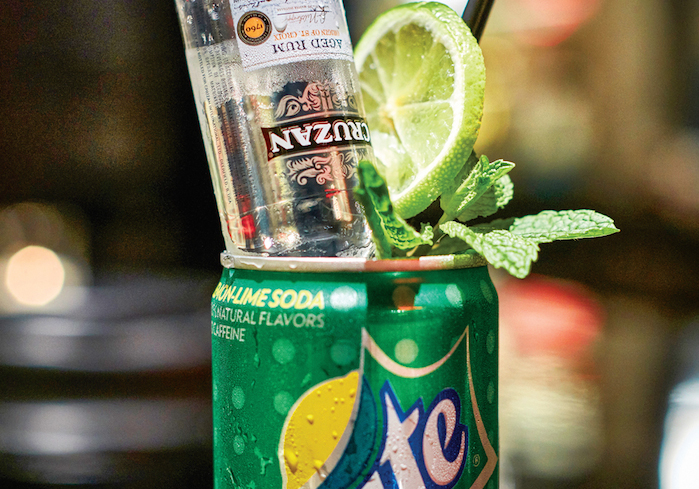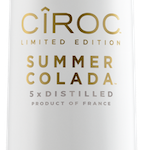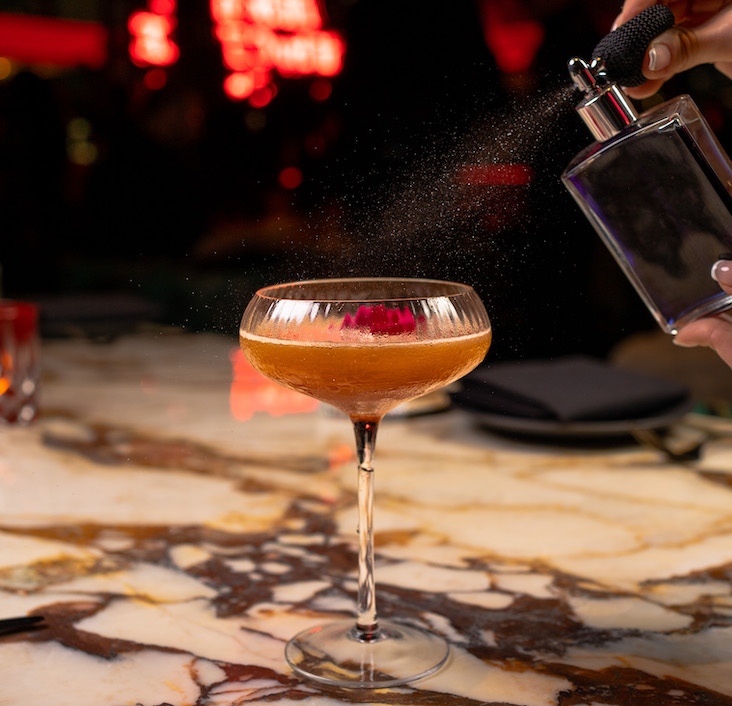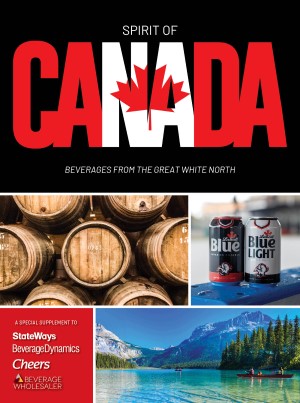People have been adding flavor to beverage alcohol for centuries. Gin, for instance, is a neutral spirit that gets its piney flavor from juniper and other botanicals, spices and citrus peels.
Commercially flavored vodkas, which hit the U.S. market some 30 years ago, are now available in a stunning array of flavors. Whiskey and rum have followed suit more recently, though the flavor expressions for these spirits have been a bit more conservative.
Will the flavors trend continue in beverage alcohol? We interviewed several on-premise operators to get their take on the three major categories of flavored spirits.
Vodka
A neutral spirit, vodka is the ideal vehicle for flavors of all kinds. While flavored vodkas have been around since the mid 1980s, thanks to Absolut and Stolichnaya, the trend really picked up in the past decade. Earliest entrants were simple citrus or fruit flavors.
Then came the quest for the holy flavor grail, including the confectionary phase with success stories like whipped cream and cake. Following those hits came a plethora of flavor releases, some rather far out, such as pickle, mimosa and sriracha, to name just a few.
Backbars and retailers shelves became overcrowded, and now flavor fatigue seems to be setting in. Or perhaps fickle customers are straying to categories other than vodka for their flavor fix.
The fallout is that producers are reining in flavor proliferation, concentrating attention on core flavors. Bar and restaurant operators have weeded out dusty unused flavors to focus the most versatile vodka variants.
Narrowing The Selection
“The U.S. market has been the big driver for those crazy, fun vodka flavors, like cotton candy and marshmallow fluff,” says Cindy Busi, worldwide beverage director with Hard Rock International. The Orlando, FL-based company operates 174 Cafes in 74 countries right now, 48 of which are in the U.S.
“Flavors are still resonating, but people are starting to be more of a purist in spirits,” Busi says. For Hard Rock Cafes, that means a “back to basics approach” to cocktails.
Rather than carrying multiple flavors, Hard Rock instead relies on flavor agents such as fresh fruits, flavored syrups and other modifiers. That helps to reduce SKUs on the backbars.
Easy Does It
“All of these flavors have made it easier for us at Coyote Ugly to do our job as bartenders—to get drinks out quickly,” says Marsha Mahaffey, general manager at the Coyote Ugly Saloon in San Antonio, TX. The New York-based chain has about 24 units internationally, 13 in the U.S.; it is known for its lively atmosphere, bartop dancing, and the eponymous 2000 film.
“We have a wide selection of flavored vodkas that can easily mix with soda, juices or Red Bull,” Mahaffey says. Coyote Ugly’s core list includes 10 flavors of vodka, with options such as Loopy by Three Olives and Deep Eddy Grapefruit. The latter is a flavor that Mahaffey sees as trending upwards.
“We ask customers, what flavor are you looking for—orange, strawberry, watermelon?” says Mahaffey. The bartender can pick the desired flavored vodka off the rail, just add soda and the drink is ready to serve.
If the customer wants a sweeter drink, it’s enhanced with juice or punch, she adds. As an example, Deep Eddy Lemon with soda and a splash of 7Up is priced at $7.
Point Of Entry
“I don’t think flavored liquors will ever completely go out of style because somebody’s always turning 21,” says Mike Di Tota, cocktail director at gastropub The Bonnie in Astoria, NY, part of the Bua Bar Restaurant Group. “There’s always going to be somebody playing catch up, discovering cocktails, and drinking in general.”
For that group, he says, drinks like blueberry vodka and soda are point-of-entry cocktails. The Bonnie carries half a dozen flavored vodkas from Stolichnaya and Absolut. The brands are well known and don’t use any artificial flavorings or sweeteners, says Di Tota. “People mostly drink them as vodka sodas, and we sell a lot of those.”
“I tell people, try everything but drink what you like, that’s all that counts,” says Xan McLaughlin, operating partner at the Park Cafe in Charleston, SC. “When we first opened, we had a minimal selection behind the bar because I wanted our customers to tell me what they wanted.”
Park Café attracted an eclectic group of guests: Some come in just for the cocktail program and are excited when the list changes, other customers want the house classics. “Then we have lots of ‘ladies who lunch’ who love their Cosmos.”
For that latter group, McLaughlin always keeps an assortment of three flavored vodkas behind the bar. “Selection always has to do with your clientele base.”
Genuine Flavors
New York bar Genuine Liquorette is set up like a liquor store, “and we are not too snobby about what we carry,” says Eben Freeman, head of beverage development and bar operations for parent company Avroko Hospitality Group. “I have every flavor of Pinnacle vodka, Skyy vodka and Burnett’s vodka. I definitely have a lot of flavored spirits in my bar.”
Opened in fall 2015, one of the aims at Genuine Liquorette was to promote under-represented spirits, which includes flavored whiskey, rum and vodka.
Bottles on the wall, such as Burnett’s vodka, are sold by the gram at 15 cents per gram. So a drink would cost about $5. Made by Heaven Hill, Burnett’s is not too well known in New York, notes Freeman, but people who went to school down south will get nostalgic and do shots.
Genuine Liquorette has gained Instagram fame with its Cha-Chunkers, unusual cocktail presentations involving cans and mini liquor bottles. For instance, its version of the Cosmopolitan comes in a cranberry juice can, with fresh lime juice and Cointreau, topped with a upside down bottle of Absolut Citron. The drinks are priced at $10.59.
“The novelty helps sell the drinks, but also the familiarity,” says Freeman. “It may look weird, but it is still a Cosmopolitan.”

New York’s Genuine Liquorette, which opened in the fall of 2015, aims to promote under-represented spirits, which includes flavored whiskey, rum and vodka.
Hard’s Core
Hard Rock Cafe’s core menu offers a number of cocktails using flavored vodka. One prime example is its press drinks. These combine spirits with fresh fruits in a French press pot, which brings the infusion experience tableside.
The Red Berry Press, launched in 2014, is house-made lemonade, Svedka Clementine vodka and fresh lemons, strawberries and raspberries. The Raspberry Lemonade version uses Smirnoff Raspberry vodka.
A recent promotion featured the Sweet & Firey, with house- made lemonade, Absolut Peppar vodka, Domain de Canton ginger liqueur, DeKuyper blue curaçao and ginger beer with a red pepper garnish. There is a contrast between sweet and spicy, says Busi, and the ginger beer is certainly on-trend. “The blue curaçao added a color pop, which contrasts with the bright red pepper, which lets you know you’re going to hit some heat.”
Whiskey
Whiskey of all kinds—from bourbon and rye to Irish and Scotch—is by far the hottest category in the beverage alcohol industry right now. Novice drinkers often enter the brown spirits arena via flavored versions.
Jim Beam pioneered with the launch of Red Stag Black Cherry back in 2009. But the spicy cinnamon Canadian whisky Fireball set the category on fire following a 2006 rebranding. That inspired other whiskey makers to release their own versions as well as introduce other flavors—honey, apple, maple and more—which are also finding success in the U.S. market.
On Fire
“The story I like to tell is that I have people come in who want three shots of Fireball,” says Freeman. “There is the automatic reaction of a mixolgist or fine-dining bartender to tell them, ‘I don’t have Fireball.’ Which I don’t, but I do have four products that are just like Fireball,” he adds.
Beam Kentucky Fire and Cinerator are among the stock at Genuine Liquorette. “If people keep asking for some kind of spirit, it seems silly not to have it in your bar,” Freeman says. Among the flavored whiskeys on the market right now, a cinnamon-hot variant is the most useful, he adds.
“We make our own version of Fireball in-house,” says Di Tota of The Bonnie. He infuses bourbon with cinnamon sticks for three days and combines that with a jalapeno-infused simple syrup for a sweet heat. “We call it the Red Hot Shot,” he says, “and that’s how we get around not stocking Fireball.”
Hot and spicy flavors are trending in cocktails right now, says Di Tota. The Bonnie also carries Virgil Kaine ginger bourbon on the backbar.
Flavored whiskeys—flavored spirits in general—appeal to younger drinkers, aged 21 to 30, says the cocktail director. “For those who haven’t yet developed a palate for straight whiskey, flavors mask the spirits’ taste and make them easier to drink,” Di Tota says.
While McLaughlin admits that Fireball is likely one of the top-selling spirits in the U.S., he only stocks a maple-flavored whiskey. “Maple is a natural flavor to pair with bourbon,” he adds.
“If I hear from customers who want a certain type of drink or a different flavor, I’ll talk with my reps about what’s selling well, then do some taste tests, and make a decision from there,” says Mahaffey at Coyote Ugly. Mahaffey stocks eight different flavors of whiskey.
At Coyote Ugly, bartenders entertain and dance as well as tend bar, so using flavored whiskeys and other spirits as a base helps to speed drink service. An example is Cinnamon Toast Crunch ($10), which combines Jack Daniel’s Tennessee Fire with RumChata cream liqueur.
When it comes to trends, Mahaffey says that drinks that combine spirits with beer or hard cider are becoming more popular. The bar offers a bomb-type drink, dropping a shot of Jack Fire into a glass of Angry Orchard Cider. “It kind of tastes like apple pie, which works well during the holidays,” she says.
Sweet Heat
“Spice is starting to resonate more; it surfaced a couple of years ago, with items like sriracha, now it’s much more acceptable, especially sweet heat,” says Hard Rock’s Busi. She cites brands like Fireball that have cinnamon flavor, but tend toward hot and are geared toward Millennials and Gen-Xers as a straight shot. “We are finding greater ability to mix with those flavors, adding that spice to cocktails.”
Honey is another key bourbon flavor, says Busi, along with maple and apple.
The Hard Rock team uses a number of resources to select its core list. For instance, the Hard Rock beverage council, which draws upon the expertise of 10 to 20 Cafes across the globe, talks about what’s on trend, Busi says, and certainly, flavored whiskeys and rums are hot topics.
She also drills down to specific markets. “Obviously, around Kentucky bourbon country, we would be remiss not to have as many whiskeys as possible,” she points out. “But the Hard Rock Cafe in Key West probably doesn’t need nine to 10 of them.”
Considering off-premise trends are also important when creating cocktail lists. “Consumers who are drinking maple- or honey-flavored whiskeys at home might be intrigued into trying some different recipes when they are out at a restaurant or bar,” Busi says.
Flavored whiskeys have appeared in a number of cocktail promotions throughout the year. Showing up as part of Hard Rock’s World Burger Tour was the All Jacked Up, which featured both Jack Daniel’s Tennessee Whiskey and Jack Daniel’s Tennessee Honey, along with Sailor Jerry spiced rum, balanced with pineapple and lime juices and orgeat.
A star in Hard Rock Café’s Mix It Up program of holiday- focused cocktails was the Bourbon Milk Punch, made with Jim Beam Red Stag bourbon, RumChata, Monin Spiced Brown Sugar syrup and milk, topped with whipped cream, a caramel drizzle and spiced pecans. The Velvet Rain was a Sangria made with red wine, Southern Comfort, Chambord black raspberry liqueur, tropical juices and fresh berries.
One possibility Busi is looking at for 2017 is offering cocktails on tap. “We would execute one as a ‘mother cocktail’,” she explains, “and then offer four or five variations by adding flavored spirits.”

“I don’t think flavored liquors will ever completely go out of style, because somebody’s always turning 21.” — Mike Di Tota, cocktail director at gastropub The Bonnie in Astoria, NY, part of the Bua Bar Restaurant Group.
Rum
Unlike the vodka segment, rum flavors have generally hewed closely to Caribbean fruit flavors such as coconut and pineapple. Players getting into the spice market are offering new takes on that traditional style.
Evolution in the spiced rum realm is moving toward oak-aged, darker spirits finished at a higher proof with a dryer profile. For example, Destillería Serrallés in Puerto Rico launched its first spiced rum in the Don Q line; it is an aged product, with a base blended from 3- to 6-year-old rums, a dry profile and bottled at 90 proof.
“At Hard Rock Café, we trend higher in rum and flavored rums, which has to do a lot with our core customer,” says Busi. The average guest visits Hard Rock for celebratory occasions or while on vacation, and has a permission slip to be a little indulgent. So they are more apt to try twists on Pina Coladas, Daiquiris or Sangria, she notes.
Rum drives those categories of cocktails, Busi adds. “The rum category continues to grow in new flavors; it seems like there is a new one on the market every month and it’s hard to play catch up.”
Indeed, the bright spot for rum these days is the vibrant flavored segment, especially the spiced variants. Of the top- 10 leading rum brands, more than half are flavored/spiced specialists, according to the Handbook Advance from the Beverage Information Group. Led by Captain Morgan at the number-two slot, other flavor-centric brands in the lineup are Malibu coconut rum, Admiral Nelson’s, Sailor Jerry, The Kraken and Captain Morgan’s Parrot Bay.
Spice Of Life
“I don’t even consider spiced rum a flavor,” says Di Tota at The Bonnie. The addition of Caribbean ingredients like allspice make spiced seem more like another type of rum than a flavor, he explains.
At the restaurant, spiced rum is featured in cocktails, especially during the fall and winter. Plus, guests can order cider with an added shot of spiced rum.
“I think we will see more spiced and flavored rums on the market because of the changing relationship with Cuba,” Di Tota predicts. “We’ll see a surge in interest in rum of all kinds.”
At the Park Café, manager Lauren Jones created a drink called the Roscoe, made with Captain Morgan spiced rum (or the Chairman’s Reserve, if you want to step it up, she says), Pamplemousse grapefruit liqueur, maple bitters and ginger beer, garnished with a grapefruit peel. Despite a small and crowded backbar, Park Café always stocks a spiced rum because of customer demand.
Show Time
Malibu rum is a key ingredient in one of the top-selling drinks at Coyote Ugly, according to Mahaffey. It’s a proprietary version of the Vegas Bomb: Malibu and Coyote Ugly Whiskey dropped into a glass of Red Bull. The concoction is priced at $10, considerably more than other drinks, but can account for 50% to 70% sales when promoted.
“One of the things that make us different is the ability to advertise in the bar on the microphone through comedy and wit,” says Mahaffey. “We’ll get on the microphone and say, ‘Hey, for the next hour we are doing Bomb Time; everybody’s doing them.’ That encourages people to try our specialty.”
Its liquor-store-like set up enables Genuine Liquorette to feature every flavor of Cruzan rum, every flavor of Bacardi rum and many flavors of Malibu rum, according to Freeman. Personally, he’s partial to Plantation pineapple rum.
Genuine Liquorette’s Pina Colada Cha- Chunker cocktail ($10.59) is served in an open can of pineapple juice with upended bottle of Malibu rum, with a pineapple leaf for a straw. The uniquely presented drink is one of the bar’s best sellers.
Seasonal Spins
“In the summer we were heavy, heavy on rum-flavored drinks,” says Busi at Hard Rock. As an example, she cites a drink with cherry-flavored rum and cherry liqueur. “We also took some of the classic style drinks and kicked them up a notch with flavored rums.”
A classic Daiquiri but made with a spiced rum, for example, or adding orange-flavored rum to Sangrias. “That’s been a big platform for us with our Mason Jars. Seemingly familiar, but adding a differentiator with some cool flavors,” Busi says.
Whereas consumers might not buy four or five flavors of rum for using at home, they might be more likely to sample those different rums at a Hard Rock Café, she explains.
“People may be familiar with the Bacardi brand, say, and so have the trust and willingness to try Bacardi Dragonberry or its coconut, orange or cherry flavors,” Busi says. “We have a lot of fun with that.”
Thomas Henry Strenk is Brooklyn-based writer specializing in all things drinkable.







